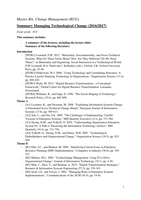Samenvatting
Samenvatting Managing Technological Change; MTC
- Instelling
- Rijksuniversiteit Groningen (RuG)
Exam grade: 10.0 Lecturer: Mueller Samenvatting van Managing Technological Change: - A summary of the lectures, including the lecture slides - Summary of all course literature:
[Meer zien]




